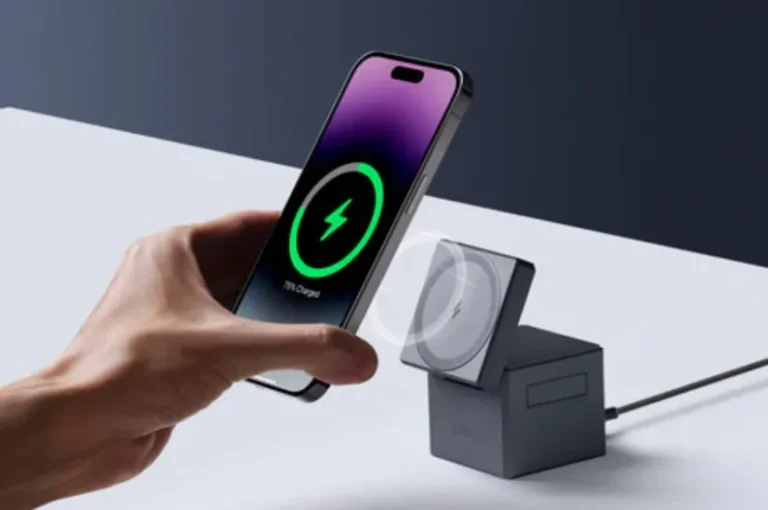Wireless charging transforms the way we keep our devices powered. Eliminating the tangle of cables, it delivers unprecedented convenience and a modern touch to our daily tech habits. But, how does this fascinating technology work? In this guide, we uncover the principles behind wireless charging, delve into the technology powering it, and examine its safety and effectiveness. By understanding these elements, you can appreciate not only how wireless charging keeps your devices running but also the benefits and limitations involved. Let’s begin this comprehensive guide to explore the intricacies of wireless charging.
What Is Wireless Charging and How Does It Work?
If you are considering about if is wireless charging bad for battery, then the following information will make the answer clear.
Definition of Wireless Charging
Wireless charging, also known as inductive charging, is a method of charging batteries without the need for a physical connection. Instead, it uses electromagnetic fields to transfer energy from a charger to a device. The device simply needs to be placed on the charging pad for the energy transfer to happen.
How Energy Transfer Happens Without Wires
Energy transfer in wireless charging occurs through electromagnetic induction. A charging pad, equipped with a coil, generates an alternating electromagnetic field. When a device with a compatible coil is placed on the pad, the field induces an electrical current in the device’s coil, which then charges the battery.
Key Differences from Traditional Charging
Traditional charging relies on conductive charging where a direct electrical connection is established through a cable. Wireless charging eliminates this need, offering a clutter-free and more convenient method. It reduces wear and tear on both cables and device ports, potentially extending their usability.
The Technology Behind Wireless Charging Explained
Electromagnetic Induction
Electromagnetic induction is the core principle behind wireless charging. It was discovered by Michael Faraday in the 1830s. Here’s how it works: the charging station has a transmitter coil that creates a magnetic field when an electric current passes through it. If a receiver coil in a device is in proximity, the magnetic field induces a current in the receiver coil, charging the device. This magnetic coupling is temporary, active only when the device is correctly positioned on the pad.
Components Involved in Wireless Charging
Key components of wireless charging include the transmitter (charging pad) and the receiver (device’s coil). The transmitter includes a power source, a controller, and a coil. The receiver consists of the device’s rectifier circuit and coil. When the device is placed on the charging pad, these components work together to ensure efficient energy transfer from the pad to the device.
Types of Wireless Charging: Inductive vs. Resonant
How Inductive Charging Works
Inductive charging uses an electromagnetic field between two coils to transfer energy. It’s the most common type and is used in devices like smartphones and smartwatches. This method requires close alignment between the device and the charging pad, with a short range of typically a few millimeters.

Understanding Resonant Charging
Resonant charging, on the other hand, allows for greater distances between the charger and the device. It also uses electromagnetic fields but differs in that both the transmitter and receiver coils are tuned to resonate at the same frequency. This enables charging over a larger distance and can be effective even if the coils are not perfectly aligned.
Is Wireless Charging Safe and Effective for Your Devices?
Safety Considerations for Wireless Charging
Wireless charging is generally safe. It has built-in features that prevent overheating and overcharging. Most wireless chargers and devices contain mechanisms to stop charging once the battery is full, reducing risks of battery damage. However, it’s essential to use certified chargers to avoid any safety issues.
Pros and Cons of Wireless Charging
Pros include convenience, reduced wear on device ports, and a tidier charging setup. However, wireless charging can be slower compared to wired charging. It also requires the device to be placed on a pad, limiting mobility during charging.
Efficiency Compared to Wired Charging
Wireless charging efficiency varies but is typically lower than wired charging. Wired charging can reach efficiencies of around 85-95%, while wireless charging generally hovers around 60-80%. This translates to longer charging times and can influence energy consumption.
Conclusion
Wireless charging brings a level of convenience that is revolutionizing the way we power our devices. By understanding the underlying technology, the differences from traditional methods, and the safety implications, users can make informed choices about incorporating wireless charging into their daily routines. Its growing presence suggests a shift towards more seamless, user-friendly tech interactions, marking a significant step forward in device management and convenience. As technology evolves, so will the efficiency and applications of wireless charging, potentially making it the standard for all devices in the future.
